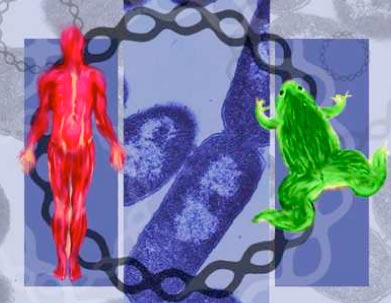Concept 34 Genes can be moved between species.

Because of the universality of the genetic code, the polymerases of one organism can accurately transcribe a gene from another organism. For example, different species of bacteria obtain antibiotic resistance genes by exchanging small chromosomes called plasmids. In the early 1970s, researchers in California used this type of gene exchange to move a "recombinant" DNA molecule between two different species. By the early 1980s, other scientists adapted the technique and spliced a human gene into E. coli to make recombinant human insulin and growth hormone.
Recombinant DNA technology — genetic engineering — has made it possible to gain insight into how genes work. In cases where it is impractical to test gene function using animal models, genes can first be expressed in bacteria or cell cultures. Similarly, the phenotypes of gene mutations and the efficacy of drugs and other agents can be tested using recombinant systems.
 DNA is packaged in a chromosome.
DNA is packaged in a chromosome. Higher cells incorporate an ancient chromosome.
Higher cells incorporate an ancient chromosome. Some DNA does not encode protein.
Some DNA does not encode protein. Some DNA can jump.
Some DNA can jump. Genes can be turned on and off.
Genes can be turned on and off. Genes can be moved between species.
Genes can be moved between species. DNA responds to signals from outside the cell.
DNA responds to signals from outside the cell. Different genes are active in different kinds of cells.
Different genes are active in different kinds of cells. Master genes control basic body plans.
Master genes control basic body plans. Development balances cell growth and death.
Development balances cell growth and death. A genome is an entire set of genes.
A genome is an entire set of genes. Living things share common genes.
Living things share common genes. DNA is only the beginning for understanding the human genome.
DNA is only the beginning for understanding the human genome.